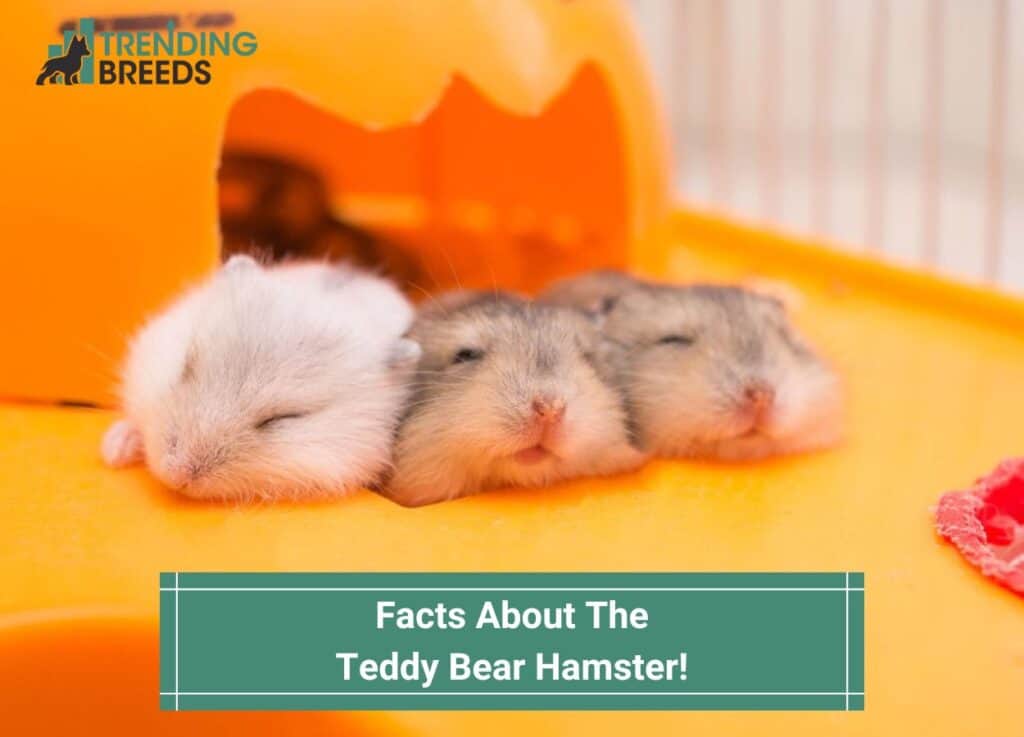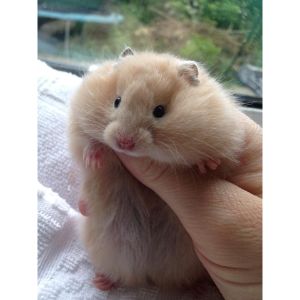
Teddy bear hamsters have recently become the talk of the town as the cutest little things. With their adorable features and small-sized teddy bear appearance, it’s hard to resist bringing one home when you see one.
In this article, we go through 13 exciting facts about the teddy bear hamster with regard to its origins, anatomy, diet, temperament, and personality.
Keep reading below for more information.
Before you scroll further down this guide, check out these other animal-related articles: Interesting Facts About the Gray Cane Corso and Interesting Facts About Blue Rhodesian Ridgeback Puppies.
Table of Contents
What is a Teddy Bear Hamster?

The teddy bear hamster does not belong to a different species of rodent but is rather a common nickname for Syrian hamsters due to their resemblance to small stuffed teddy bears.
There is much discussion about whether the name “teddy bear hamster” refers specifically to a Syrian hamster with particularly long fur or to any Syrian hamster because they resemble teddy bears.
But in practice, it doesn’t make much of a difference; since we’re talking about just a nickname here, you can refer to your hamster as a “teddy bear hamster” if it’s a Syrian hamster.
Since long-haired Syrian hamsters are so uncommon, most hamster pictures you’ll find online feature the more common short-haired variety.
If your Syrian hamster reminds you of a teeny tiny teddy bear with big ears, dark brown eyes, and an adorable little nose, then you officially have a teddy bear hamster.
13 Facts About the Teddy Bear Hamster

Origins
Some people don’t put much thought into their pets’ backstories or where they came from. Learning about it, however, can be fun! And a fantastic opportunity to display your thorough understanding of teddy bear hamsters.
Teddy bear hamsters were first captured in 1930 by Israeli zoologist Israel Aharoni in Aleppo, Syria. Most modern teddy bear hamsters can trace their ancestry to that first captive generation.
In 1936, Syrian hamsters began arriving in the United States. These tiny animals became famous after being launched on the British pet market a decade later. In 1945, the first hamster club was established. There is also the Midland Hamster Club in England and the California Hamster Association, both of which specialize in teddy bear hamsters.
Nocturnal

Nocturnal animals, like teddy bear hamsters, are dormant during the day and awake at night.
This applies to hamsters in the wild and those kept as pets. It also makes sense, given that Syria, their ancestral homeland, experiences hot days and cool nights.
Although this may seem like an odd selling point for a pet, a hamster’s sleeping habits make them a fantastic pick, especially for those who must attend work or school during the day.
This is ideal for people who want to leave their pet at home during the day while they go to work or school and then spend time with it in the mornings or evenings.
This also means your bedroom might not be the best location for their cage. They can make much noise when burrowing and working out.
Polyandrous
Long-haired teddy bear hamsters are known to be polyandrous, meaning they have more than one partner.
The male hamster will mate with any available female he finds throughout the mating season, if she hasn’t yet given birth.
They are very territorial, and the female will drive the male out of the burrow once they have finished mating.
Personality

The unique character of a fancy teddy bear hamster is another plus for keeping one as a pet.
This golden hamster is an excellent household pet because of its pleasant demeanor. Your hamster will grow to adore being held if you introduce it to handling at a young age.
Curious and fearless, your fancy bear hamster will enjoy the freedom to run, burrow, and discover its surroundings.
Nevertheless, when they’re shocked or frightened, they may bite. Although they are small, their bites can be quite painful. If you want to handle your hamster, you should take precautions to avoid shocking him.
Avoid waking him by reaching into his cage without first talking to him. Don’t poke or prod him to wake up; use your voice.
Friendly
Hamsters are loved as pets by people of all ages. They’re easy to care for, small, entertaining, and thrive in confined spaces.
They may even welcome your arms if you know how to handle them. Some hamster breeds are more active and playful than others, and they will enjoy spending time with you.
The long-haired teddy bear hamster, however, is the best of the bunch because it genuinely is the most sociable.
Visual Aid Through Hip Glands

Like other hamsters, the teddy bear hamster has poor vision. They rely on scent glands situated near their hips to aid their vision.
They explore their environment by rubbing their hips against objects and sniffing them. We refer to the areas where these olfactory glands are located as “hip spots.”
Lifespan
Do you want to know how long teddy bear hamsters typically live? There isn’t a single correct answer.
The average lifespan of a domesticated hamster is significantly higher than that of a wild Syrian hamster. The average lifespan of a wild teddy bear hamster is between one and two years.
However, teddy bear hamsters kept as pets typically live for three years or more. The commitment to this pet is longer than getting a fish or a hamster but shorter than getting a dog.
A record has been set for the longest-living hamster. The record-holding hamster in the Guinness Book of World Records was 4.5 years old.
Solitary

A fancy bear hamster is a fantastic option for a first pet because of its independent nature.
The Russian Dwarf hamster is one such species that thrives when kept with another of its kind. The Syrian hamster, however, must be housed individually. Its natural habitat is solitary.
It’s possible that two teddy bear hamsters would fight if you introduced them. So, store one separately.
This is not necessarily a bad thing. Having only one pet can make life much simpler and less stressful, especially if this is your first pet.
Never-Ending Tooth Development
This is another characteristic shared by hamsters. Teddy bear hamsters, like other hamsters, need to gnaw on an object to keep their teeth short regularly.
They can frequently be seen gnawing on twigs and other complex objects. Their teeth will continue growing and could cause harm if they don’t trim them regularly.
Many Different Colors and Patterns

A wide variety of colors and patterns are available in teddy bear hamsters, making them attractive as pets. This means that each family member is unique in its way.
More than 40 distinct color patterns are found in this hamster species. Cinnamon, grey, yellow, black, and chocolate are just a few hamster colors available.
Many of them have white underbellies. However, they can also have to identify marks and designs all over their bodies that are either light or dark. Perhaps you don’t care what color your hamster is. But even so, it can be a great way to build excitement for a new pet in the hearts of young children.
Herbivores
Hamsters enjoy a wide variety of foods, including seeds, grains, nuts, broken maize, and fresh produce. In addition to bugs, frogs, and lizards, wild hamsters will eat other small animals.
The Canadian Federation of Humane Societies recommends providing them with a diet of at least 16% protein and 5% fat.
Pouches

Teddy bear hamsters, as their name implies, have cheek pouches. They stuff their cheek pouches with food and run away when they spot a predator. This allows them to reach a secure area. They need not worry about going hungry!
There have been reports of fibers being stored in their cheek pouches.
The hamsters can save up for materials to make a nest out of. Syrian hamsters have the necessary supplies in their cheek pouches to quickly and easily reconstruct their comfortable homes after moving away from a location.
In captivity, hamsters will frequently conceal their possessions beneath their bedding.
Sharp Teeth
Even though these hamsters are more commonly seen in captivity, they can exhibit aggressive tendencies when necessary. The teeth of Syrian hamsters are particularly pointed.
As such, they can use them to protect themselves from potential threats. Although the hamster has sharp teeth, it won’t be able to do much if its larger opponent has a bigger size.
How to Look After a Teddy Bear Hamster

In this section, we’ll cover the basics of hamster care.
- Provide clean water in a bottle for your hamster at all times. The average hamster’s daily water requirement is about 10 ml, though this can vary depending on the hamster’s size.
- Ensure you give your hamster the right nutrition; a teddy bear hamster needs approximately two teaspoons of food daily. Remember that they tend to bury their food, so you should limit the amount you give them to prevent obesity and the health problems that come with it.
They prefer to eat grains and seeds but will occasionally snack on insects. Sometimes, a tiny bit of cooked, unseasoned meat or egg white is acceptable.
- Get a cage that’s big enough. This is a frequent problem among those who have just started caring for hamsters. The small size of hamsters often leads us to believe they can be housed in a smaller cage than necessary.
- Keep your hamster’s cage clean at all times. Compared to other small animals, hamsters have the least stinky cages and are relatively easy to care for. However, there are times when you’ll need to clean the hamster’s cage.
- To foster a close relationship with your teddy bear hamster, you should play with it several times a week if its temperament permits. The teddy bear hamsters are the most active and social, and they are much easier to tame than their smaller dwarf cousins.
- Make sure your hamster gets plenty of exercise and gnawing. In addition to a sizable hamster wheel, you can keep your pet active by purchasing various hamster toys, such as stairs, bridges, tunnels, chewing toys, and more.
Considerations for Pet Owners Considering a Teddy Bear Hamster

If you’re considering getting a teddy bear hamster as a pet, here are some things you should know.
Costs
The actual cost of keeping a teddy bear hamster as a pet is more than you may think. It’s essential to mention that the hamster is the cheapest part of the purchase. Before purchasing a hamster, it is important to research the prices of accessories like the cage, wheel, and bedding.
You should see if there are any hamster donation programs in your area. The hamster’s cage and toys are also likely to be donated.
Different Characteristics

Hamsters have unique personalities; just because you saw someone interacting with a teddy bear hamster on YouTube as if it were a puppy does not mean you will have the same experience with your hamster. Many hamsters are not social or easily trained due to their unique personalities.
While teddy bear hamsters are more social than their dwarf counterparts, remember that they are solitary creatures and are not meant to live in groups.
Frequently Asked Questions
Do teddy bear hamsters need baths?
Most hamsters don’t need baths, unless your vet seems to think they do.
Do hamsters need salt licks?
Hamsters do need salt licks. A little bit of salt or a rock with salt should be enough.
Do hamsters like cold water to drink?
Hamsters don’t like cold water, and it can harm them by lowering their body temperature rapidly.
Facts About The Teddy Bear Hamster

Knowing important things about an animal is important before you adopt it.
We hope this article was helpful in imparting some interesting facts about teddy bear hamsters that you can read while you wait for your pet.
If you find this guide, “Facts About The Teddy Bear Hamster,” informative and helpful, you can check out these other animal-related articles from our team:
- Facts About the Toy Cavapoo
- Facts About the Brown and White Maltipoo Puppy
- Interesting Facts About the Phantom Bernedoodle
You can learn more about this animal by watching “Hamster Dos & Don’ts” down below:




